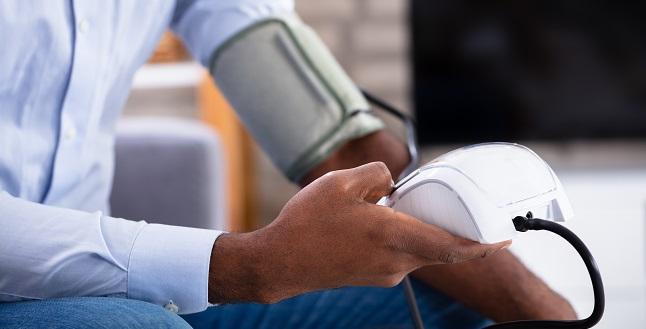Telehealth Program Helps Minority Stroke Survivors Control BP
Adding nurse case management to home BP telemonitoring led to big declines in BP in Hispanics and African-Americans.

LOS ANGELES, CA—Combining home blood pressure telemonitoring and nurse case management can result in substantial drops in BP among low-income Hispanic and African-American patients who’ve had a stroke within the past year and have uncontrolled hypertension, a randomized trial shows.
Patients randomly assigned to home BP telemonitoring alone had declines in BP over the first year of follow-up, but the patients who also had 20 phone calls with a nurse case manager saw a reduction in systolic BP that was 7.32-mm Hg greater at 6 months and 9.24-mm Hg greater at 1 year (P < 0.0001 for both). Gbenga Ogedegbe, MD (NYU Grossman School of Medicine, New York, NY), reported the results at the International Stroke Conference here last week.
“We strongly believe that these findings provide strong empirical evidence for the widespread implementation of these strategies in low-income, minority stroke survivors with multiple comorbidity,” Ogedegbe said during his presentation. “Policy makers and healthcare plans now have the needed evidence and information to implement these strategies, [and] pay for them, in this patient population.”
He noted that his team is still adjudicating stroke outcomes through 2 years of follow-up and evaluating the cost-effectiveness of the telehealth program.
Bruce Ovbiagele, MD (University of California, San Francisco), an American Stroke Association spokesperson, told TCTMD the cost-effectiveness analysis will be key because nurse case management is resource-intensive.
That said, he commented, there are known racial/ethnic disparities in stroke outcomes, with people from minority groups—particularly African-Americans—having worse outcomes, and this trial shows that BP can be better controlled in these populations using this approach. That will likely have a positive impact on recurrent stroke rates, he added.
“I think the results were very, very robust,” Ovbiagele said. “And so I think it’s extremely important for people who serve such communities to strongly consider trying to incorporate this because it seems to make a huge difference in terms of managing their blood pressure after a stroke.”
Sustained Reductions in BP
Both home BP telemonitoring and nurse case management are known to be effective at overcoming barriers to hypertension control at the patient, provider, and system levels, but they have not been tested in patients after stroke, Ogedegbe said. Moreover, he noted, implementation of the strategies is suboptimal in African-Americans and Hispanics.
For this trial, the investigators enrolled 450 patients from those two racial/ethnic groups (mean age 62years; 44% women) who were recruited from comprehensive stroke centers and primary care practices housed at six public hospitals and three academic centers in New York City. All patients had had an ischemic or hemorrhagic stroke in the past year, had a modified Rankin Scale score of 0 to 3, and had a systolic BP of 140 mm Hg or higher on two separate visits. Overall retention in the study was 80%.
More than 70% of the participants had a yearly family income of less than $25,000. Comorbidities were frequent: 48% had diabetes, 46% were obese, and 31% had at least three comorbid conditions. “So we’re talking about a really low-income, multimorbidity patient population,” Ogedegbe said.
Half of the patients had nurse case management added on top of that. That involved 20 counseling calls with a nurse, weekly for the first 2 months, biweekly for the next 2 months, and then monthly for the rest of the first year. The nurses evaluated patients’ electronic health records and self-reports, counseled participants on targeted lifestyle behaviors, and advised patients in response to the home BP data.
Significant declines in systolic BP were observed in both groups by 6 months, with sustained effects out to 1 year. However, the impact was greater in patients who received additional nurse case management; separation of the curves started at 2 to 3 months.
With home BP telemonitoring alone, patients saw mean systolic readings fall from 148.03 mm Hg at baseline to 141.72 mm Hg at 6 months. At 1 year, BP remained lower than at baseline (142.50 mm Hg).
The combination of home BP telemonitoring and nurse case management reduced mean systolic BP from 150.03 mm HG at baseline to 136.41 mm Hg at 6 months. It ticked slightly lower still at 1 year (135.27 mm Hg).
At 1 year, mean systolic BP had declined by 14.76 mm Hg with the combined strategy and by 5.53 mm Hg with home BP telemonitoring alone (P < 0.0001). Greater declines in diastolic BP also were seen with the addition of nurse case management.
Whether these gains will be worth the resources expended to achieve them remains to be seen, Ovbiagele said, noting that healthcare systems would want to offer these approaches to all patients and not just those from racial/ethnic minority groups. “But if you do have a Latino-rich and African-American population,” he said, “I think it’s reassuring to know that this works in these populations for whom blood pressure is hard to manage.”
Todd Neale is the Associate News Editor for TCTMD and a Senior Medical Journalist. He got his start in journalism at …
Read Full BioSources
Ogedegbe G. Comparative effectiveness of home BP telemonitoring (HBPTM) plus nurse case management vs HBPTM alone among minority stroke survivors. Presented at: ISC 2020. February 21, 2020. Los Angeles, CA.
Disclosures
- The trial was funded by the National Institute of Neurological Disorders and Stroke.
- Ogedegbe and Ovbiagele report no relevant conflicts of interest.


Comments